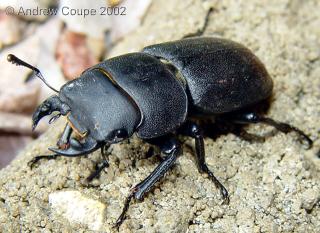Lucanus cervus
Dorcus parallelipipedus
Cetonia aurata
Amphimallon solstitialis [1]




Anal opening longitudinal, surrounded by 2 characteristic lobes. For more click here.
Anal opening longitudinal, surrounded by subtly different lobes. For more click here.
Anal opening transverse.
It is the easiest larva to identify correctly.
Click on the picture for a better view of the larva.
Anal opening transverse.
All the larvae are on their backs with their heads to the right.
 C shaped, all facing the same way.
C shaped, all facing the same way.
 C shaped, all facing the same way.
C shaped, all facing the same way.
 Kidney shaped, practically circular, rather dark.
Kidney shaped, practically circular, rather dark.
 Kidney shaped; the spiracles nearer the head face the other way.
Kidney shaped; the spiracles nearer the head face the other way. Tree stumps, old trees and shrubs, rotting fence posts, decorative logs, compost heaps and leaf-mould piles. Mostly under the ground in natural situations. However it can be found feeding above the ground in log piles, etc. Note the galleries that the larvae have made. Scale is in 1 cm divisions.

Shares the habitat with the stag beetle but it prefers to feed above the ground. It is a kind of upstairs-downstairs arrangement.
Above is a picture of its larval galleries in a fence post which they shared with the stag beetles. The rule at the top is 15 cm long.

It may share the habitat with the stag beetle, but it is very frequently found in compost, leaf-mould and manure heaps in great numbers. They are the equivalent of earth worms and help break things down so they are very beneficial.
Gardeners quite often believe that they are stag beetle's larvae, which is no problem as both are very beneficial decomposers.
Click on the picture for another clutch.

Feeds on fresh roots, does great damage; usually associated with lawns.
They are not to be found in decaying wood or the compost heap.

Curls up in a C or rolls up on its back as if being tickled. Also it often defecates as a reaction to being handled. Video

The same as for the stag beetle. It also defecates often, like it does in this video; lighter coloured frass because it does not feed in the soil-wood interface.

If placed on a flat surface will crawl on its back! Video
In the U.S.A. larvae with similar behaviour are called “crawly-backs”.

If placed on a flat surface it will 'run' dragging its tail end behind. Video

Below the surface in a soil compacted cocoon, the size of an orange.

Above the ground in the wood where it has been feeding.

In the soil/compost in a soil compacted cocoon, the size of a blackbird's egg.
 In the soil, near where it has been feeding. This is the pupa from the larva shown at the top. Notice its exuvia, top right corner.
In the soil, near where it has been feeding. This is the pupa from the larva shown at the top. Notice its exuvia, top right corner.
Click on the picture to view more photos.

Click on the picture to view more photos.
Click on the picture to view more photos.

Click on the picture to view another likely culprit, the true cockchafer. [1]
Just leave them where they are as they don't seem to respond well to being moved.